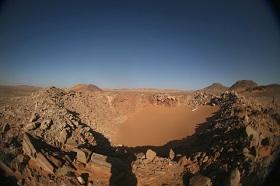Using AI to control energy for indoor agriculture
30 September 2024
Published online 28 July 2010

The bowl-shaped, 45-metre wide crater was first spotted by Vincenzo De Michele, former curator at Museo Civico di Storia Naturale in Milan, Italy, during a Google Earth survey in 2008.
A specialist geophysical survey, organised as part of the 2009 Egyptian-Italian Year of Science and Technology, studied the crater in greater detail earlier this year and estimated that an iron meteorite, around 1.3 metres in diameter, struck the site several thousand years ago.
The Kamil Crater is named after the mountain Gebel Kamil, which stands nearby in the Sahara desert.
"The most remarkable aspect of this crater is the perfect preservation of all elements and evidence of the meteorite impact event: geometry of the crater, rays of ejecta, and thousands of the meteorite pieces in and around the crater," said Ahmed El-Barkooky, professor at the Faculty of Sciences, Cairo University, Egypt.
Ejecta rays are the streaks left by the explosion of debris outwards from the site of an impact. They are clearly visible around craters on the moon where the lack of an atmosphere means no life or weather can erode the characteristic surface features. However, they are rarely found on Earth.
"The Kamil Crater is so well-preserved that it represents a model crater for small impacts on the Earth's crust," said Luigi Folco, meteorite curator at the Museo Nazionale dell'Antartide in Siena, Italy, and co-author of the study published in this week's Science1.

Nature Middle East
Though scientists figure that thousands of similarly small meteorites hit Earth over the past million years, active geological processes and atmospheric weathering have cleared much of the Earth's surface of impact craters. Only 15 small craters have been identified to date. The Kamil Crater shows very few signs of erosion, retaining most of its original features.
"As liquid water is one of the most effective weathering agents, geological structures are well-preserved under the hyper-arid climatic condition of the southwestern Egyptian Sahara," explained Folco.
Geophysical models predict that iron meteorites less than 1,000 tonnes would be ripped apart by Earth's atmosphere before impact with the ground. Based on the measurements at Kamil Crater, a meteorite weighing approximately 9.1 tonnes and travelling at 12,600 km per hour made impact.
According to these models, it should have broken into pieces when it hit the atmosphere, but it did not.
"We observe that the meteorite impacted the ground intact, contrary to current models," said Folco. "This changes the impact scenario and thus has implications for hazard assessment."
The fact that there is only one crater, rather than a crater field, suggests that the meteorite passed through Earth's atmosphere mostly intact. "We inspected the area carefully through remote sensing analyses and we could not see other impact structures. Also, the whole area has been previously well-beaten by other scientists in the search from impact craters. And they did not find any," explained Folco.
"There is proof on the ground now providing opposing evidence to [the initial] model," added El-Barkooky, who also co-authored the study.
The study suggests that 35% of meteorites smaller than 1,000 tonnes may make it through the atmosphere intact.
"Judging by this crater, such an impact would cause damage in a 2-5 km radius. In the desert this is not too bad, but if this hits a residential area in one of the cities it would be devastating," said El-Barkooky. "It really all depends on where the meteorite hits."
The exact age of the crater remains unknown. However, the researchers report that, based on its pristine condition, it is probably relatively young.
"Both meteorite and ejecta pieces are found to cover prehistoric human-built structures in the area," said El-Barkooky.
Humans that lived in the Sahara desert are thought to have migrated to the lush Nile valley during droughts that hit the area approximately 5,300 years ago. El-Barkooky suggests the meteorite must have hit the area after it was deserted, making the crater around 5,000 years old.
doi:10.1038/nmiddleeast.2010.181
Stay connected: